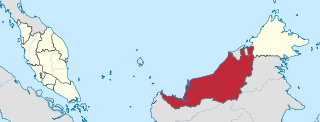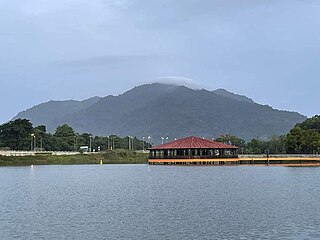
Sarawak is a state of Malaysia. The largest among the 13 states, with an area almost equal to that of Peninsular Malaysia, Sarawak is located in the region of East Malaysia in northwest Borneo, and is bordered by the Malaysian state of Sabah to the northeast, Kalimantan to the south, and Brunei in the north. The capital city, Kuching, is the largest city in Sarawak, the economic centre of the state, and the seat of the Sarawak state government. Other cities and towns in Sarawak include Miri, Sibu, and Bintulu. As of the 2020 Malaysia census, the population of Sarawak was 2.453 million. Sarawak has an equatorial climate with tropical rainforests and abundant animal and plant species. It has several prominent cave systems at Gunung Mulu National Park. Rajang River is the longest river in Malaysia; Bakun Dam, one of the largest dams in Southeast Asia, is located on one of its tributaries, the Balui River. Mount Murud is the highest point in the state. Sarawak is the only state of Malaysia with a Christian majority.

Kuching, officially the City of Kuching, is the capital and the most populous city in the state of Sarawak in Malaysia. It is also the capital of Kuching Division. The city is on the Sarawak River at the southwest tip of the state of Sarawak on the island of Borneo and covers an area of 431 km2 (166 sq mi) with a population about 165,642 in the Kuching North administrative region and 159,490 in the Kuching South administrative region—a total of 325,132 people.

Serian is a town, and the capital of the Serian separated on 11 April 2015 from Samarahan Division, Sarawak, Malaysia. It is located about 40 miles (64 km) from Kuching. Sub-district headquarters towns are Balai Ringin and Tebedu.

The Ibans or Sea Dayaks are an Austronesian ethnic group indigenous to northwestern Borneo. The Ibans are also known as Sea Dayaks and the title Dayak was given by the British and the Dutch to various ethnic groups in Borneo island.

Bidayuh is the collective name for several indigenous groups found in southern Sarawak, Malaysia and northern West Kalimantan, Indonesia, on the island of Borneo, which are broadly similar in language and culture. The name Bidayuh means 'inhabitants of land'. Originally from the western part of Borneo, the collective name Land Dayak was first used during the period of Rajah James Brooke, the White Rajah of Sarawak. At times, they were also lesser referred to as Klemantan people. They constitute one of the main indigenous groups in Sarawak and West Kalimantan and live in towns and villages around Kuching and Serian in the Malaysian state of Sarawak, while in the Indonesian province of West Kalimantan they are mainly concentrated in the northern Sanggau Regency. In Sarawak, most of Bidayuh population can be found within 40 km of the geographical area known as Greater Kuching, within the Kuching and Serian Division. They are the second-largest Dayak ethnic group in Sarawak after the Iban and one of the major Dayak tribes in West Kalimantan.

The Royal Ranger Regiment is an infantry regiment of the Malaysian Army. Although it is second in seniority to the Royal Malay Regiment, the RRD can trace its origins back to the mid 19th century and the establishment of The Sarawak Rangers, the peacekeeping force in the Sarawak region. This force was absorbed by the Sarawak Constabulary in 1932, but the name was revived in 1941 as a British Colonial unit; this unit commanded by British Lieutenant Colonel C.M. Lane was captured by the Japanese in 1942.

Song is a town, and the capital of the Song District in Kapit Division, Sarawak, Malaysia. The district population was 20,046 according to the 2010 census. Song is situated by the banks of the Katibas River, a tributary of the Rajang River. It is an important stopover for river traffic going up the Rajang River.

Betong is a town in Betong Division in Sarawak, Malaysia, lying in the Saribas area. It was formerly under the Sri Aman district. Betong is located between three main rivers, Batang Lupar, Batang Saribas and Batang Kelaka, and covers an area of 4,180 km2.

Kuching Division is one of the twelve administrative divisions in Sarawak, Malaysia. Formerly part of what was called the "First Division", it is the center and the starting point of modern Sarawak. Kuching Division has a total area of 4,559.5 square kilometres.

Bau is a gold mining town, capital of Bau district in the Kuching Division of Sarawak, Malaysia.

Mount Pueh, also known as Mount Pueh-Berumput, Mount Poi and Mount Poe, is a mountain located near Lundu, Sarawak on the Malaysia-Indonesia border. Mount Pueh was known to biologists for the collections made there by Eric Mjöberg (1882–1938), a Swedish naturalist, who was Curator of the Sarawak Museum between 1922 and 1924. Mjöberg's herpetological collections from Gunung Pueh between October and December 1923, and other localities in Borneo, were reported by Smith (1925). Mjöberg, unfortunately, left little by way of written records, of his ascent of Pueh and the collections he made.

The History of Sarawak can be traced as far as 40,000 years ago to the paleolithic period where the earliest evidence of human settlement is found in the Niah caves. A series of Chinese ceramics dated from the 8th to 13th century AD was uncovered at the archeological site of Santubong. The coastal regions of Sarawak came under the influence of the Bruneian Empire in the 16th century. In 1839, James Brooke, a British explorer, first arrived in Sarawak. Sarawak was later governed by the Brooke family between 1841 and 1946. During World War II, it was occupied by the Japanese for three years. After the war, the last White Rajah, Charles Vyner Brooke, ceded Sarawak to Britain, and in 1946 it became a British Crown Colony. On 22 July 1963, Sarawak was granted self-government by the British. Following this, it became one of the founding members of the Federation of Malaysia, established on 16 September 1963. However, the federation was opposed by Indonesia, and this led to the three-year Indonesia–Malaysia confrontation. From 1960 to 1990, Sarawak experienced a communist insurgency.
Biawak is a settlement in Lundu District, Sarawak, Malaysia. It lies approximately 70.6 kilometres (44 mi) west of the state capital Kuching, very close to the border with Indonesian Kalimantan.

The Fort Sylvia is a historical fort in Kapit, Sarawak, Malaysia. Built in 1880, it was renamed after Rani Sylvia Brooke, wife of Rajah Charles Vyner Brooke, in 1925. During the 1960s, the fort housed the District Office and the District Court House, and later the Resident's Office when Kapit Division was formed in 1973.
Sarawak's population is very diverse, comprising many races and ethnic groups. Sarawak has more than 40 sub-ethnic groups, each with its own distinct language, culture and lifestyle. This makes Sarawak demography very distinct and unique compared to its Peninsular counterpart. However, it largely mirrors to other territories in Borneo - Sabah, Brunei and Kalimantan.

Sematan is a small town settlement in Lundu District, Sarawak, Malaysia. It lies approximately 67.5 kilometres (42 mi) west-north-west of the state capital Kuching, which is a two-hour drive.
Opar is a state constituency in Sarawak, Malaysia, that has been represented in the Sarawak State Legislative Assembly since 2006.
Tanjong Datu is a state constituency in Sarawak, Malaysia, that has been represented in the Sarawak State Legislative Assembly since 1991.
The Gunung Gading National Park is a national park in Lundu District, Kuching Division, Sarawak, Malaysia. The park is located roughly two hours drive from Kuching, and is a popular destination for seeing the Rafflesia flower in bloom. After 10 years as a conservation zone to protect the Rafflesia, the park opened to visitors in 1994. The park also has a number of jungle trails to waterfalls or to the 965m summit of Gunung Gading.
Datu Patinggi Abang Ali bin Abang Amir or commonly known as Datu Patinggi Ali, was a key figure in the Sarawak Malays' resistance to the Brunei Empire, which they waged throughout Pengiran Indera Mahkota and Raja Muda Hashim's reign in the 1830s. He became one of the first supporters of the Brooke Raj and hailed as Sarawak's first national hero. An important part in the 1830s uprising against Bruneian authority was played by him. In an endeavor to oppose Brunei's attempts to subjugate Sarawak through local leaders, he is known to be a fearless and resolute leader. Brooke then took Ali as an aide-de-camp after the Sarawak dispute ended.



















